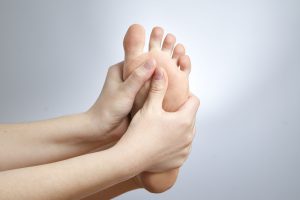Medically Reviewed by Dr. Rachel N. Verville
September 21, 2016
 Diabetic foot problems, such as nerve damage (or Diabetic Neuropathy) and reduced blood flow to your feet are serious issues for Frisco area patients that can cause even more severe consequences. Currently, 30,000,000 people in the United States are diabetic, with over 1,000,000 new patients being diagnosed every year. At the same time, more than 65,000 lower limbs are amputated every year due to diabetic issues. And once you’ve had one amputation, your odds of requiring another amputation within the next 3 to 5 years are as high as 50%. Thankfully, there is hope. By including a skilled podiatrist in your Diabetic care plan, you can reduce the risk of amputation by 85% and lower the risk of hospitalization by 24%.
Diabetic foot problems, such as nerve damage (or Diabetic Neuropathy) and reduced blood flow to your feet are serious issues for Frisco area patients that can cause even more severe consequences. Currently, 30,000,000 people in the United States are diabetic, with over 1,000,000 new patients being diagnosed every year. At the same time, more than 65,000 lower limbs are amputated every year due to diabetic issues. And once you’ve had one amputation, your odds of requiring another amputation within the next 3 to 5 years are as high as 50%. Thankfully, there is hope. By including a skilled podiatrist in your Diabetic care plan, you can reduce the risk of amputation by 85% and lower the risk of hospitalization by 24%.
What is Diabetic Neuropathy?
Diabetic Neuropathy is a type of nerve damage that occurs in people with Diabetes. Symptoms of Diabetic Neuropathy include numbness or the reduced ability to feel temperature changes in your feet. Also, there can be tingling or burning sensations, sharp pains or cramps in the feet, increased sensitivity to touch along with muscle weakness, loss of balance and coordination, loss of reflexes and serious foot conditions including ulcers, infections, deformities, and bone and joint pain. With Diabetic Neuropathy, small issues can quickly turn into bigger problems. That’s why it’s important to have small cuts, blisters, ulcers and infections immediately treated by a Frisco area podiatrist like Dr. Verville.
What is Poor Circulation of the Feet?
Peripheral Arterial Disease (PAD) often causes poor circulation in Diabetic feet. With PAD, arteries in the legs narrow and harden as a result of fatty plaque deposits, which in turn causes decreased blood flow in the legs and feet. This results in a variety of symptoms, including cramping leg pain when walking, tingling, numbness and coldness in the legs and feet, and slow to heal cuts and sores on the feet. Just like with Diabetic Neuropathy, small issues like cuts, ulcers or blisters, can take a while to heal, easily become infected and turn into bigger issues.
What’s the Solution to Diabetic Foot Care?
The best method of treating Diabetic feet is to make sure that small issues don’t turn into big ones, as they often do for people with Diabetes. That’s why all cuts, blisters, and foot ulcers should be evaluated by an experienced Frisco area podiatrist. It may seem a bit extreme to come into your podiatrist’s office with something that most would consider a small inconvenience, but when it comes to Diabetic foot care, you can never be too careful. Slow to heal wounds can become infected, and in the worse case scenario, require amputation.
I’m a Diabetic, but I Don’t See a Podiatrist. What Should I Do Next?
If you’re a Diabetic in the Frisco area, it’s best that you start seeing an experienced podiatrist like Dr. Verville, now. After all, podiatrists can reduce your risk for an amputation by 85%! It’s time that you make your foot health a priority.
Call Frisco area podiatrist Dr. Verville today at (214) 385-8822 to schedule a comprehensive examination of your feet.









